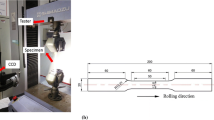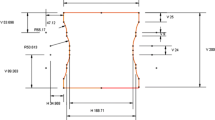Abstract
The influence of high strain rate on the forming limit curves of AA6082-T6 aluminum alloy sheets, 1 mm in thickness, was investigated by means of dynamic tensile and hemispherical punch tests carried out until the onset of sample failure using a Split Hopkinson Bar (SHB) system, at a punch speed of 7500 and 12000 mm/s. The equipment used was designed according to the standard EN ISO 12004-2 but properly scaled to adapt it to the SHB apparatus. A finite element analysis was performed to quantify the strain rate values reached during tests (around 600 and 1000 s-1 associated at the punch speeds of about 7500 and 12000 mm/s, respectively). The limit strains were determined on different sample geometries undergoing deformation in the range from the uniaxial and balanced biaxial stress states typical for sheet metal forming processes. The major and minor strain distributions, acquired through an accurate image analysis by analyzing the deformation of a previously imprinted grid on the specimen surface, allowed to plot the dynamic forming limit curves at different high strain rate values. Such forming limit curves were compared with those provided by samples deformed under quasi-static loading condition, using the same equipment and specimen geometries, in order to evaluate the influence of the loading rate on the formability. It was observed that the formability of AA6082-T6 aluminum alloy strongly improves as the strain rate increases from quasi-static to dynamic conditions.
Graphical abstract


























Similar content being viewed by others
Data availability
The authors confirm that the data supporting the findings of this study are available within the article. The raw data are available from the corresponding author upon a request.
References
Seth M, Vohnout VJ, Daehn GS (2005) Formability of steel sheet in high velocity impact. J Mater Process Technol 168:390–400. https://doi.org/10.1016/j.jmatprotec.2004.08.032
Li S, Cui X, Li G (2018) Modelling and demonstration of electromagnetically assisted stamping system using an interactive mapping method. Int J Mech Sci 144:312–323. https://doi.org/10.1016/j.ijmecsci.2018.06.003
Soltanpour M, Fazli A, Niaraki RJ (2017) High speed hydroforming and direct quenching: an alternative method for production of hot stamped parts with high productivity. Procedia Eng 207:317–322. https://doi.org/10.1016/j.proeng.2017.10.781
Oliveira DA, Worswick MJ, Finn M, Newman D (2005) Electromagnetic forming of aluminum alloy sheet: free-form and cavity fill experiments and model. J Mater Process Technol 170:350–362. https://doi.org/10.1016/j.jmatprotec.2005.04.118
Psyk V, Risch D (2012) Chapter 11: high-velocity forming. In: Altan T, Tekkaya AE (eds) From: sheet metal forming processes and applications. ASM International, Cleveland, pp 227–248
Bruschi S, Altan T, Banabic D, Bariani PF, Brosius A, Cao J, Ghiotti A, Khraisheh M, Merklein M, Tekkaya AE (2014) Testing and modelling of material behaviour and formability in sheet metal forming. CIRP Ann Manuf Technol 63:727–749. https://doi.org/10.1016/j.cirp.2014.05.005
Sato K, Yu Q, Hiramoto J, Urabe T, Yoshitake A (2015) A method to investigate strain rate effects on necking and fracture behaviors of advanced high-strength steels using digital imaging strain analysis. Int J Impact Eng 75:11–26. https://doi.org/10.1016/j.ijimpeng.2014.07.001
Hu M l, Song W d, Duan D b, Wu Y (2020) Dynamic behavior and microstructure characterization of TaNbHfZrTi high-entropy alloy at a wide range of strain rates and temperatures. Int J Mech Sci 182:105738. https://doi.org/10.1016/j.ijmecsci.2020.105738
Xiao D, Li Y, Hu S, Cai L (2010) High strain rate deformation behavior of zirconium at elevated temperatures. J Mater Sci Technol 26:878–882. https://doi.org/10.1016/S1005-0302(10)60140-5
Sasso M, Forcellese A, Simoncini M, Amodio D, Mancini E (2015) High strain rate behaviour of AA7075 aluminum alloy at different initial temper states. Key Eng Mater 651–653:114–119
Smerd R, Winkler S, Salisbury C, Worswick M, Lloyd D, Finn M (2005) High strain rate tensile testing of automotive aluminum alloy sheet. Int J Impact Eng 32:541–560. https://doi.org/10.1016/j.ijimpeng.2005.04.013
Kim SB, Huh H, Bok HH, Moon MB (2011) Forming limit diagram of auto-body steel sheets for high-speed sheet metal forming. J Mater Process Technol 211:851–862. https://doi.org/10.1016/j.jmatprotec.2010.01.006
Balanethiram VS, Daehn GS (1994) Hyperplasticity: increased forming limits at high workpiece velocity. Scr Metall Mater 30:512–520
Balanethiram VS, Hu X, Altynova M, Daehn GS (1994) Hyperplasticity: enhanced formability at high rates. J Mater Process Technol 45:595–600
Daehn GS, Altynova M, Balanethiram VS, Fenton G, Padmanabhan M, Tamhane A, Winnard E (1995) High-velocity metal forming—An old technology addresses new problems. JOM 47:42–45. https://doi.org/10.1007/BF03221230
Forcellese DA, El Mehtedi M, Simoncini M, Spigarelli S (2007) Formability and microstructure of AZ31 magnesium alloy sheets
Choi Y, Lee J, Panicker SS et al (2020) Mechanical properties, springback, and formability of W-temper and peak aged 7075 aluminum alloy sheets: Experiments and modeling. Int J Mech Sci 170. https://doi.org/10.1016/j.ijmecsci.2019.105344
Ambrogio G, Bruni C, Bruschi S, Filice L, Ghiotti A, Simoncini M (2008) Characterisation of AZ31B magnesium alloy formability in warm forming conditions. Int J Mater Form 1:205–208. https://doi.org/10.1007/s12289-008-0027-y
Pham QT, Lee BH, Park KC, Kim YS (2018) Influence of the post-necking prediction of hardening law on the theoretical forming limit curve of aluminium sheets. Int J Mech Sci 140:521–536. https://doi.org/10.1016/j.ijmecsci.2018.02.040
Simoncini M, Cabibbo M, Forcellese A (2016) Development of double-side friction stir welding to improve post-welding formability of joints in AA6082 aluminium alloy. Proc Inst Mech Eng B J Eng Manuf 230:807–817. https://doi.org/10.1177/0954405414560618
Kiliclar Y, Engelhardt M, von Senden genannt Haverkamp H, Schwarze M, Vladimirov I, Bormann D, Reese S, Bach Fr-W, (2011) Combined quasi-static-dynamic forming processes - material modelling, experimental validation and finite element technology. In: Hirt G (ed) Special edition: 10th International Conference on Technology of Plasticity, ICTP 2011 [held in Aachen, Germany on September 25th–30th, 2011]. Verl, Stahleisen GmbH (Steel research international Special edition), Düsseldorf, pp 865–870
Rohatgi A, Stephens EV, Soulami A, Davies RW, Smith MT (2011) Experimental characterization of sheet metal deformation during electro-hydraulic forming. J Mater Process Technol 211:1824–1833. https://doi.org/10.1016/j.jmatprotec.2011.06.005
Chu YY, Lee RS, Psyk V, Tekkaya AE (2012) Determination of the flow curve at high strain rates using electromagnetic punch stretching. J Mater Process Technol 212:1314–1323. https://doi.org/10.1016/j.jmatprotec.2012.01.017
Yaşar M, Demirci HI, Kadi I (2006) Detonation forming of aluminium cylindrical cups experimental and theoretical modelling. Mater Des 27:397–404. https://doi.org/10.1016/j.matdes.2004.11.005
Kiliclar Y, Demir OK, Engelhardt M, Rozgić M, Vladimirov IN, Wulfinghoff S, Weddeling C, Gies S, Klose C, Reese S, Tekkaya AE, Maier HJ, Stiemer M (2016) Experimental and numerical investigation of increased formability in combined quasi-static and high-speed forming processes. J Mater Process Technol 237:254–269. https://doi.org/10.1016/j.jmatprotec.2016.06.007
Verleysen P, Peirs J, Van Slycken J et al (2011) Effect of strain rate on the forming behaviour of sheet metals. J Mater Process Technol 211:1457–1464. https://doi.org/10.1016/j.jmatprotec.2011.03.018
Sasso M, Mancini E, Chiappini G, Simoncini M, Forcellese A (2018) Adapted Nakazima test to evaluate dynamic effect on strain distribution and dome height in balanced biaxial stretching condition. Int J Mech Sci 148:50–63. https://doi.org/10.1016/j.ijmecsci.2018.08.024
Mancini E, Sasso M, Rossi M, Chiappini G, Newaz G, Amodio D (2015) Design of an innovative system for wave generation in direct tension–compression Split Hopkinson bar. J Dyn Behav Mater 1:201–213. https://doi.org/10.1007/s40870-015-0019-1
(2008) ISO 12004-2:2008 Metallic materials — Sheet and strip — Determination of forming-limit curves — Part 2: Determination of forming-limit curves in the laboratory. 27
Fardmoshiri M, Sasso M, Mancini E et al (2017) Identification of Constitutive model parameters in Hopkinson bar tests. In: Quinn S, Balandraud X (eds) Residual Stress, Thermomechanics & Infrared Imaging, Hybrid Techniques and Inverse Problems Conference Proceedings of the Society for Experimental Mechanics Series. Springer, Cham, pp 189–198
Kalpakjian S, Schmid SR (2014) Manufacturing - engineering and technology, 8th edn. Pearson/Australia, Frenchs Forest
Sasso M, Callegari M, Amodio D (2008) Incremental forming: an integrated robotized cell for production and quality control. Meccanica 43:153–163. https://doi.org/10.1007/s11012-008-9124-8
Tamimi S, Andrade-Campos A, Pinho-da-Cruz J (2015) Modelling the Portevin-Le Chatelier effects in aluminium alloys: a review. J Mech Behav Mater 24:67–78. https://doi.org/10.1515/jmbm-2015-0008
Lumelskyj D, Rojek J, Lazarescu L, Banabic D (2019) Determination of forming limit curve by finite element method simulations. Procedia Manuf 27:78–82. https://doi.org/10.1016/j.promfg.2018.12.047
Magrinho JP, Silva MB, Reis L, Martins PAF (2019) Formability limits, fractography and fracture toughness in sheet metal forming. Materials (Basel) 12:15. https://doi.org/10.3390/ma12091493
Djapic Oosterkamp L, Ivankovic A, Venizelos G (2000) High strain rate properties of selected aluminium alloys. Mater Sci Eng A 278:225–235. https://doi.org/10.1016/S0921-5093(99)00570-5
Chen Y, Clausen AH, Hopperstad OS, Langseth M (2009) Stress-strain behaviour of aluminium alloys at a wide range of strain rates. Int J Solids Struct 46:3825–3835. https://doi.org/10.1016/j.ijsolstr.2009.07.013
Iyama H, Itoh S (2010) Study on explosive forming of aluminum alloy. Int J Multiphys 4:341–349. https://doi.org/10.1260/1750-9548.4.4.341
Forcellese A, Simoncini M (2020) High-speed deformation of pinless fswed thin sheets in aa6082 alloy. Metals (Basel) 10. https://doi.org/10.3390/met10010015
Habibi N, Sundararaghavan V, Prahl U, Ramazani A (2018) Experimental and numerical Investigations into the failure mechanisms of TRIP700 steel sheets. Metals (Basel) 8:1–17. https://doi.org/10.3390/met8121073
Gerdooei M, Mollaei Dariani B, Liaghat GH (2009) Effect of material models on formability of sheet metals in explosive forming. In: Proceedings of the World Congress on Engineering 2009, vol II, WCE 2009, July 1–3, 2009, London, UK
Acknowledgments
The authors wish to thank Dr. Massimiliano Pieralisi and Dr. Luciano Greco for their support in carrying out the experimental tests.
Author information
Authors and Affiliations
Contributions
Michela Simoncini: conceptualization; investigation; data curation; methodology; writing—original draft. Archimede Forcellese: conceptualization; resources; writing—review and editing. Edoardo Mancini: conceptualization; investigation; data curation; software; validation. Gianluca Chiappini: software; visualization; writing—original draft. Marco Sasso: resources; supervision; writing—original draft.
Corresponding author
Ethics declarations
Ethical approval
The article is original. It is not under consideration by another journal and has not been published previously.
Declaration of competing interest
The authors declare that they have no known competing financial interests or personal relationships that could have appeared to influence the work reported in this paper.
Additional information
Publisher’s note
Springer Nature remains neutral with regard to jurisdictional claims in published maps and institutional affiliations.
Highlights
• The effect of high strain rate on formability of AA6082-T6 alloy was investigated.
• Dynamic hemispherical punch tests were performed using a Split Hopkinson Bar.
• The results of dynamic tests were compared to those given by quasi-static tests.
• The formability of AA6082-T6 strongly improves at high-speed deformation tests.
• The vertical position and shape of FLCs are strongly affected by strain rate.
Rights and permissions
About this article
Cite this article
Simoncini, M., Forcellese, A., Mancini, E. et al. Experimental and numerical investigation on forming limit curves of AA6082 aluminum alloy at high strain rates. Int J Adv Manuf Technol 112, 1973–1991 (2021). https://doi.org/10.1007/s00170-020-06448-7
Received:
Accepted:
Published:
Issue Date:
DOI: https://doi.org/10.1007/s00170-020-06448-7




